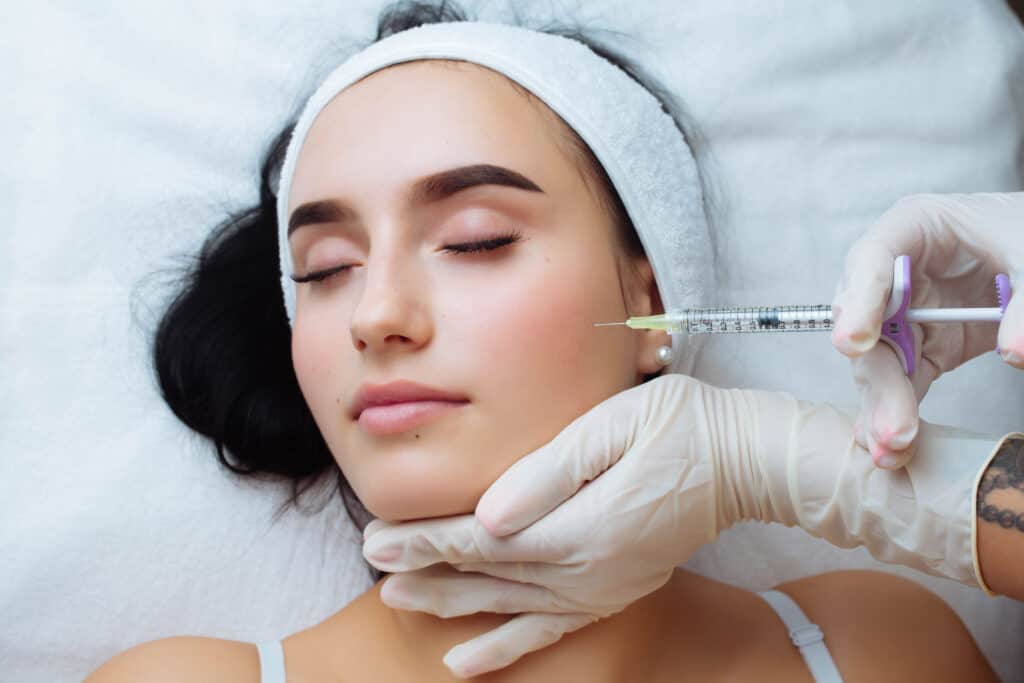Key Takeaways:
- Botox is derived from botulinum toxin and temporarily paralyzes muscles to reduce wrinkles.
- Botox can be used for medical conditions such as migraines and excessive sweating.
- Botox can subtly enhance facial features and be used preventively for younger adults.
- Choose an experienced and qualified practitioner who stays updated with advanced techniques.
- Personalized treatment plans should be based on an initial consultation and tailored to specific facial areas.
- Safety should be prioritized throughout the procedure, and post-treatment care is important for lasting results.
- Regular follow-up appointments and combining treatments can help maintain the effects of Botox.
- Healthy lifestyle habits can optimize the benefits of Botox.
The Science Behind Botox: Understanding the Mechanism and Benefits
Botox, short for botulinum toxin, is a popular cosmetic treatment that has revolutionized the field of anti-aging. Derived from a bacterium called Clostridium botulinum, Botox works by temporarily paralyzing the muscles in the treated area, minimizing the appearance of wrinkles and fine lines. This safe and effective procedure has gained widespread recognition for its ability to restore a more youthful and rejuvenated appearance.
How Botox Works to Reduce Wrinkles and Fine Lines
As we age, the repeated contractions of facial muscles when we express ourselves can cause lines and wrinkles to form. Botox blocks the signals between nerves and muscles, reducing muscle activity in the treated area. By doing so, it prevents the muscles from contracting and creating wrinkles.
The treatment usually targets dynamic wrinkles caused by facial movements like smiling or frowning. Common areas treated with Botox include crow’s feet, forehead lines, and frown lines between the eyebrows. By relaxing the muscles responsible for these wrinkles, Botox effectively smoothens the skin and softens the appearance of fine lines.
The Medical and Aesthetic Benefits of Botox Treatment
Beyond its cosmetic applications, Botox also offers various medical benefits. It is commonly used to treat medical conditions such as chronic migraines, excessive sweating (hyperhidrosis), and muscle spasms. Botox injections can provide relief by temporarily blocking nerve signals that trigger these conditions.
From an aesthetic perspective, Botox can improve more than just wrinkles. It can also lift and sculpt certain facial features, subtly enhancing one’s appearance. For example, injecting Botox into the jawline can help create a more defined and contoured look. Additionally, Botox injections can be used to reduce the appearance of a gummy smile by relaxing the upper lip muscles.
Busting the Myths: Debunking Botox Misconceptions
Botox has gained immense popularity in recent years, but it has also been surrounded by various misconceptions. One common myth is that Botox will give you a frozen or expressionless face. However, when administered by a skilled practitioner, Botox should result in a natural-looking outcome that preserves facial expressions.
Another misconception is that Botox is only suitable for older individuals. In reality, Botox can be used as a preventive measure for younger adults to delay the onset of wrinkles. By targeting early signs of aging, individuals can maintain their youthful appearance for longer.
It is important to consult with a qualified and experienced Botox practitioner to address any concerns and dispel misconceptions before treatment. A reputable practitioner will ensure that the treatment plan is tailored to your unique needs and desired outcome.
Choosing an Expert Botox Practitioner: Essential Factors to Consider
Qualifications and Experience: What to Look for in a Botox Specialist
When considering Botox treatment, choosing a qualified and experienced practitioner is crucial. Look for a specialist who has undergone proper training in administering Botox injections. They should be licensed and certified in aesthetic medicine or a related field.
Experience is also a key factor to consider. An experienced Botox practitioner will deeply understand facial anatomy and muscle dynamics. This expertise allows them to deliver the best possible results while minimizing potential risks or side effects.
Client Testimonials: The Importance of Peer-Reviewed Feedback
One way to gauge a Botox practitioner’s expertise and reputation is by seeking client testimonials and reviews. Reading about others’ experiences can provide valuable insights into the practitioner’s skill, professionalism, and the overall quality of their service.
Look for testimonials from clients who have undergone similar treatments or have achieved the desired results that align with your goals. Positive feedback and recommendations can give you confidence in your choice of practitioner.
Advanced Techniques: Innovative Approaches for Optimal Results
Botox treatments have come a long way, and advancements in techniques have allowed for more precise and tailored outcomes. An expert Botox practitioner will stay up to date with the latest developments and incorporate advanced techniques into their practice.
These advanced techniques may include a combination of Botox with other treatments, such as dermal fillers, to achieve comprehensive facial rejuvenation. They may also utilize micro-dosing methods that provide subtle enhancements while maintaining natural facial expressions.
During your consultation, discuss with the practitioner the various techniques they employ and how they can be customized to address your unique concerns and desired outcomes.
Personalized Botox Treatment Plans: Tailoring the Procedure to Your Unique Beauty Goals
Initial Consultation: Assessing your Aesthetic Concerns and Expectations
Before proceeding with Botox treatment, a thorough consultation with a qualified practitioner is essential. During this consultation, the practitioner will assess your facial anatomy, discuss your aesthetic concerns, and understand your desired outcomes.
Be prepared to provide a detailed medical history, including any previous cosmetic treatments or allergies. This information will help the practitioner determine the suitability of Botox for you and develop a personalized treatment plan.
Creative Customizations: Adapting Botox Techniques for Different Facial Areas
Each individual’s facial anatomy is unique, and an expert Botox practitioner will consider this when planning the treatment. Different facial areas require different approaches to achieve optimal results.
For example, when treating crow’s feet, the practitioner will carefully assess the muscles around the eyes and administer Botox injections to minimize any potential drooping or asymmetry while reducing wrinkles effectively.
Similarly, when targeting forehead lines, the practitioner will consider the balance between muscle relaxation and maintaining natural facial expressions. This customized approach ensures that the treatment addresses your specific concerns while preserving your unique features.
Safety First: Minimizing Risks and Maximizing Satisfaction
While Botox is considered a safe procedure when administered by a qualified practitioner, it is essential to prioritize safety at every step of the process. The practitioner should adhere to strict hygiene protocols, use sterile equipment, and follow all recommended guidelines.
Additionally, the practitioner should provide you with detailed post-treatment care instructions and be available for any follow-up questions or concerns. This commitment to your well-being ensures that you have a positive experience and are satisfied with the results of your Botox treatment.
Long-Term Maintenance and Post-Treatment Care: Ensuring Lasting Results
Follow-Up and Touch-Up Procedures: Maintaining the Effects of Botox
Botox is not a permanent solution; the effects typically last three to six months. Regular follow-up appointments and touch-up procedures may be necessary to maintain the results.
During these appointments, the practitioner will assess the longevity of the treatment and make any necessary adjustments to ensure ongoing satisfaction. This proactive approach allows for a consistent and refreshed appearance over time.
Combining Treatments: Enhancing Botox Results with Complementary Procedures
Botox can be a valuable component of an overall facial rejuvenation plan. Combining Botox with other complementary procedures, such as dermal fillers or laser treatments, can enhance and prolong the results.
For example, dermal fillers can be used to address volume loss or enhance facial contours, while Botox focuses on muscle-related wrinkles. This combination approach provides a comprehensive solution that simultaneously targets multiple signs of aging.
When discussing your treatment plan with the practitioner, explore the potential benefits of combining different procedures to achieve your desired outcome.
Healthy Habits: Lifestyle Tips to Prolong the Benefits of Botox
While Botox can effectively reduce the appearance of wrinkles, it is important to adopt healthy habits to maximize the benefits of the treatment. Maintaining a balanced diet, staying hydrated, practicing sun protection, and avoiding smoking can all contribute to healthier, more youthful-looking skin.
In addition to these lifestyle habits, incorporating a consistent skincare routine that includes gentle cleansing, moisturizing, and using targeted anti-aging products can help prolong the effects of Botox.
Consult with your practitioner for personalized recommendations on skincare and lifestyle habits that can optimize the results of your Botox treatment.
In conclusion, the art of expert Botox cosmetic treatments lies in the precision and skill of a qualified practitioner. Understanding the science behind Botox, choosing the right practitioner, tailoring the procedure to your unique beauty goals, and maintaining long-term results through post-treatment care are all essential elements in unlocking youthful beauty through Botox. By delving deep into the topic and debunking misconceptions, this comprehensive guide has provided insights into the world of Botox and equipped you with the knowledge to make informed decisions about your cosmetic journey.
FAQ
Question: How long do the effects of Botox last?
Answer: The effects of Botox typically last for three to six months.
Question: Can Botox be used as a preventive measure for younger adults?
Answer: Yes, Botox can be used preventively for younger adults to delay the onset of wrinkles.
Question: Does Botox only treat wrinkles?
Answer: No, Botox can also be used to treat medical conditions such as migraines, excessive sweating, and muscle spasms.
Question: Will Botox give me a frozen or expressionless face?
Answer: Botox should result in a natural-looking outcome that preserves facial expressions when administered by a skilled practitioner.
Question: What should I look for in a Botox practitioner?
Answer: Look for a qualified practitioner who has undergone proper training, is licensed and certified, and has experience in administering Botox injections.
Question: Can Botox be combined with other treatments?
Answer: Yes, Botox can be combined with other treatments, such as dermal fillers, to achieve a comprehensive facial rejuvenation.
Question: How can I maintain the effects of Botox?
Answer: Regular follow-up appointments and touch-up procedures may be necessary to maintain the effects of Botox.
Question: Can adopting healthy habits prolong the benefits of Botox?
Answer: Yes, maintaining a balanced diet, staying hydrated, practicing sun protection, and avoiding smoking can help prolong the benefits of Botox.
Useful Resources:
- Medical News Today – Provides information on the science, benefits, and myths surrounding Botox, as well as insights on choosing a practitioner and personalized treatment plans.
- American Society of Plastic Surgeons – Offers comprehensive information on Botox, including its uses, how it works, and the importance of qualified practitioners.
- WebMD – Covers various aspects of Botox, including the procedure, benefits, risks, and long-term maintenance.
- Mayo Clinic – Provides in-depth information about Botox, its uses for both medical and cosmetic purposes, and what to expect before, during, and after treatment.
- RealSelf – Offers a platform for individuals to share their experiences and reviews of Botox practitioners, helping you find reputable and skilled practitioners.
- U.S. Food and Drug Administration (FDA) – Provides information on the regulation and safety of Botox and other botulinum toxins used in cosmetic procedures.
- American Academy of Dermatology (AAD) – Offers educational resources on Botox, including information on choosing a provider, what to expect from treatment, and personalized treatment plans.
- American Society for Aesthetic Plastic Surgery (ASAPS) – Provides insights into the art and science behind Botox, including considerations when selecting a qualified practitioner and the benefits of combining treatments.











